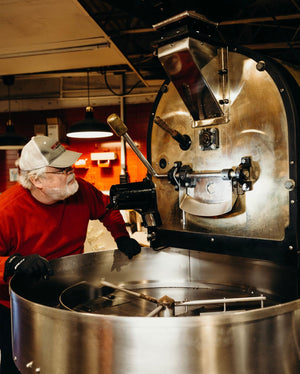
Whether you stop by one of our coffeehouses or order a bag of fresh-roasted beans from our online store, getting your hands on high-quality coffee couldn't be easier.
But the journey from the coffee fields to our roasters is a long one. So where exactly do our coffee beans come from? Read ahead for the saga.
FIRST, SOME HISTORY
While the earliest written record of coffee comes from 15th century Yemen, most historians believe that the beans originated in Ethiopia. That makes sense, because the neighboring regions were trading partners back then. Either way, coffee beans love the hot climate of Central Africa and Arabia.
Today, coffee growers across the tropics cultivate the plant, from South Asia to Central and South America. Currently, the five biggest exporters of coffee are Brazil, Vietnam, Colombia, Indonesia, and Ethiopia, where it all started.
GROWING

So where do the beans actually grow? On a coffee plant, of course!
Coffee plants ultimately reach 30 to 40 feet in height (at which point, they're technically trees). But a young coffee plant can start producing coffee cherries within two to four years.
Of course, these aren't the kinds of cherries you would put in a pie. Coffee cherries are actually seeds that grow from the plant. Growers know they are ripe when they turn cherry red.
For years, the process of picking ripe cherries was time and labor-intensive, since growers had to examine and pluck the cherries by hand. But these days, many fields are mechanized. Big tractors move through the fields to cull coffee cherries, leaving quality control to take place a little later.
DRIED AND SHIPPED

From there, coffee beans need to dry until they reduce to 11% moisture. There are two methods by which growers achieve this, the dry method and the wet method. The dry method involves laying beans out in the sun until they dehydrate as part of a natural process. This can take several weeks, as growers flip the beans periodically to ensure they are drying equally on all sides. In Ethiopia, where water is scarce, this remains the preferred, time-tested process.
The wet method, meanwhile, allows growers to wash away the pulp so that they dry faster. They are then dunked in a fermentation tank, where they remain for 24 to 48 hours until they are ready for drying. Then the beans lay in the sun, where they now dry much faster because of the washing process, which primes them.
Once they've dried, the cherries go through a milling process, which removes the outer layer of skin. They are then sorted by weight and size, and shipped across the world.
At this point, the beans are referred to as green coffee, reflecting the change the process has made in them. In the US, expert tasters check green coffee for quality before distributing the beans by the sackful across the country.
CHOOSING A SOURCE

So which sources lead to the best cup of coffee? There's no right answer.
Different coffees have different strengths. A good Colombian, for instance, should have the fruity flavor and acidity of a fine Burgundy wine. Coffee from the Mexican region of Chiapas, meanwhile, should flaunt a hint of hazelnut. Wherever we source our coffee, we make sure that the region's most renowned traits shine through.
SUSTAINING THE PRACTICE

As you can see, the process requires the hard work and dedication of countless individuals who commit their lives to harvesting this precious bean. And at San Francisco Coffee, we want to ensure that we can continue enjoying and sharing delicious coffee for years to come. That's why we're so committed to the success of coffee producers—not just today, but for the long term!
We are proud to partner with World Coffee Research, a global, collaborative nonprofit. WCR works to ensure that coffee has a future, even in the face of threats like climate change. Additionally, we've spent thirty years buying fair trade coffee from all over the world. These fair-trading partnerships place respect and transparency at the forefront, so we know that the product is as ethically produced as it is tasty.
BEANS TO CUP

Once we receive our green coffee beans, and apply our own quality tests, it's time to drop them in the roaster. We roast small batch right here in Atlanta, at our Virginia-Highland coffee house, which allows us to serve the freshest coffee possible. We also bag our coffee beans straight out of the roaster, so even our online customers get that fresh-from-the-oven taste.
Yes, the journey from the tropical fields to your mug is a long and arduous one. But that unmatched feeling you get when you enjoy your first morning sip—well, that makes it all worth it.
-Doug Bond


